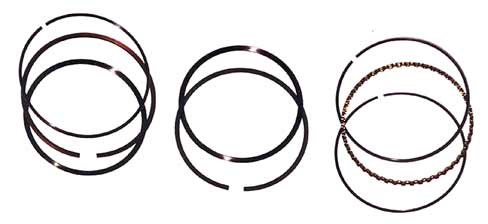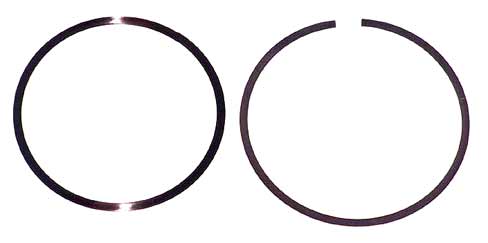| 
By Wayne Scraba
6/8/05
It’s been said that some
of the best sealing engines in all of motorsports are found
under the hood of NHRA-legal Stockers. And that could very
well be true. Just take one look at the restrictions facing
a Stock Eliminator racer: Replacement pistons with OEM ring
grooves. Limited creativity with regard to valve configurations
(and valve jobs). No add-ons such as crankcase vacuum pumps.
The methods used to seal these creations is pretty finite,
and one of the keys is the piston ring. Sound interesting?
Read on.
Now, it’s no secret that you can seal an engine pretty
well, but there are also plenty of trade-offs. And the worst
one could very well be ring drag. That’s where Stock
Eliminator becomes an enigma: Use a ring that seals the engine
tight and in many instances, you’ll be met with considerable
drag. The result is wasted horsepower. Of course, there are
plenty of clever racers out there who have figured out how
to have their cake and eat it too: The cost though, is quite
often a bunch of added maintenance: Honing cylinder walls
and re-ringing the engine in short-term intervals.
There’s more here too: Given the rules, a Stocker is
pretty much forced to race with a big, fat ring. At least
that’s what the piston rule more or less dictates. Typically,
most Stockers use a piston with some form of 5/64-inch top
and second ring groove along with a 3/16-inch (or thereabouts)
oil ring package. Big heavy rings such as this (we’re
primarily discussing the top two rings) are fine for low RPM
engines, but when the tachometer needle starts cranking hard
to the right (and more often than not, far beyond the range
the OEM manufacturer originally intended), then ring weight
becomes an issue. That’s one big reason why applications
ranging from Pro Stock to Formula 1 use skinny, light top
rings.
A heavy ring can be terribly upset by flutter. What is flutter?
Ring flutter is believed to be caused by pressure that leaks
by the top ring and but does not get by the second ring. Theory
has it this creates pressure between the top and second ring
that pushes down on the second ring and up on the top ring.
This pressure, during proper circumstances, is said to be
able to lift the top ring off its ring land creating ring
flutter.
There are a couple of theories out there on how to fix this
dilemma: One is to open the gap on the second ring, and allow
the pressure to escape. This might work, but it should also
raise some red flags: If you open the gap, then you’re
inviting blow-by, effectively kissing away the sealing capability
of the ring. It should be no surprise to any of you that filling
the oil pan with combustion gases isn’t a great idea.
And if you have no means to evacuate the crankcase, other
than something like a PCV valve and a breather, it gets even
worse. Blow-by not only robs the engine of power, it shortens
the lubrication life of the crankcase oil and it causes internal
engine parts to wear out prematurely. But in a Stocker, the
biggest problem just might be might be the fact that power
is continuously eroded as the ring gap increases in size.

This simply looks like rings. But it’s
not. This is the top ring set from the “Advantage Ring
System” manufactured by Total Seal. It’s targeted
toward the little guy racer and/or enthusiast.

|
